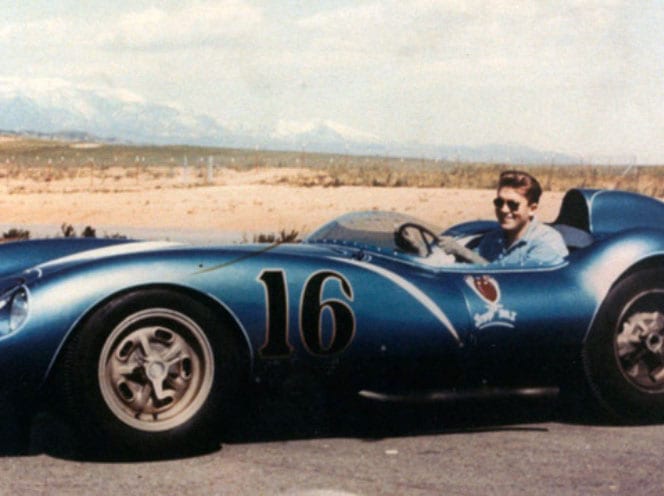
His mother was Barbara Hutton, the heiress to the F.W. Woolworth Co. department store fortune. His father was a count and, for a time, Cary Grant was his stepfather.
The most influential person in Lance Reventlow’s life, though, was yet another stepfather. Prince Igor Troubetzkoy, his mother’s fourth of seven husbands, was a race car driver — and a good one.
Among many other racing accomplishments, he won the infamous Targa Florio in 1948, the year he married Hutton. Reventlow was 12 at the time and had already experienced the sordid side of a wealthy, celebrity lifestyle.
Fortunately, for the limited length of Hutton and Troubetzkoy’s marriage, he provided stability for the youngster and instilled a passion for auto racing that provided direction and purpose to Reventlow’s life.
Never short on funds once he turned 16, Reventlow enjoyed a series of exotic cars and began racing in club events around his Hollywood home with his friend from Indiana, actor James Dean.
Reventlow’s success in those races encouraged him to move to Formula 2. He purchased a Cooper T43-Climax and spent 1957 racing in Europe. While on the continent, he considered buying a Lister-Jaguar to race in SCCA events, but decided he could build a better car.
Upon his return to the states, Reventlow formed a manufacturing company in Venice, Calif., and did just that. In only nine months his first car was finished. It was a beautiful, fierce-looking, Chevy-powered machine known as a Scarab.
The Scarabs were immediately successful in the hands of Reventlow and his driver, Chuck Daigh. The Scarab became the first U.S.-built sports car to beat Europe’s best when Daigh won the 1958 United States Grand Prix at Riverside (Calif.) Int’l Raceway.
That victory inspired Reventlow to pursue his passion to a loftier level — to build the first full-blooded, all-American, Formula One car.
To accomplish his goal, Reventlow enlisted an array of racing’s heavy hitters.
They included Dick Troutman and Tom Barnes from Kurtis Kraft; Phil Remington, who would later engineer Carroll Shelby’s Cobras; famed fabricator Emil Deidt; Jim Travers and Frank Coon, who wrenched Bill Vukovich to consecutive 500 wins; and Leo Goosen, who designed the Miller/Offy engine.
Travers recalled those days with Reventlow, “We all knew and liked each other, so it was fun every day, despite the long hours we worked to get those cars built. Needless to say, the parade of Hollywood starlets Lance brought through was a bit distracting.”
Like the Scarab sports car, the Formula One car, unveiled in 1959, was a thing of beauty. Reventlow built three — two powered with Goosen’s new engine, the third by an Offy modified by Travers and Coon.
However, the cars were of front-engine design at the time when Formula One was transitioning to rear-engine machines.
The car’s already obsolete design, combined with typical development problems, made for a dismal 1960 season. Daigh, Reventlow and, on one occasion, Richie Ginther campaigned the cars during the season’s 10 events. Daigh’s 10th-place finish at the American Grand Prix was their best showing.
Attempting to catch up with Formula One’s evolving technology, Reventlow created a rear-engine Scarab powered by a Travers and Coon-built Buick V-8 for 1961. It never competed on the Grand Prix circuit. Its only race was a Formula Libra event in Sandown Park, Australia, where Daigh finished eighth.
After that, Reventlow ordered the car cut up and rebuilt into an immensely successful, rear-engine sports car. Powered by an enormous Oldsmobile engine, several drivers, A.J Foyt being the most notable, were victorious in the last Scarab.
After investing nearly $2 million, Reventlow shuttered the Scarab operation in 1962. He leased the building to Shelby, who emulated Reventlow, and created his own sports cars — the iconic Cobras.
In 1972, Reventlow tragically perished in a plane crash while scouting for real estate to develop near his Aspen, Colo., home.
Reventlow failed in his dream to produce a winning American Formula One car. Yet, his efforts inspired others. In 1967, Dan Gurney accomplished that lofty goal.
